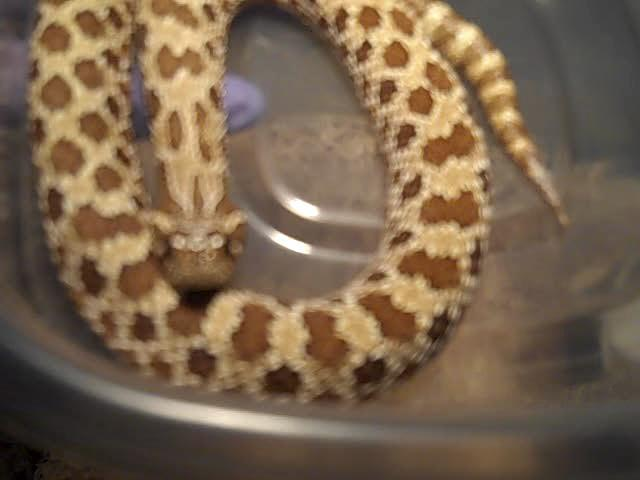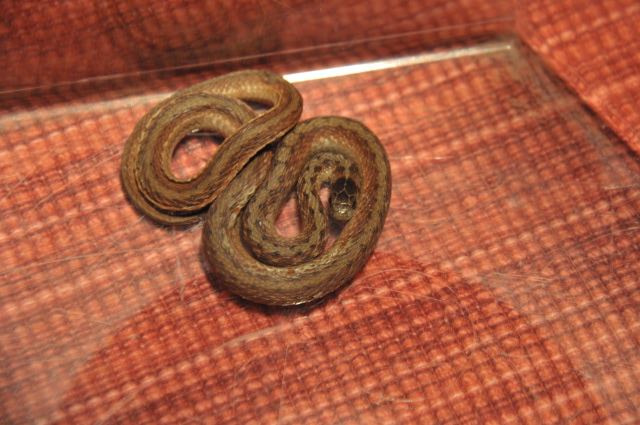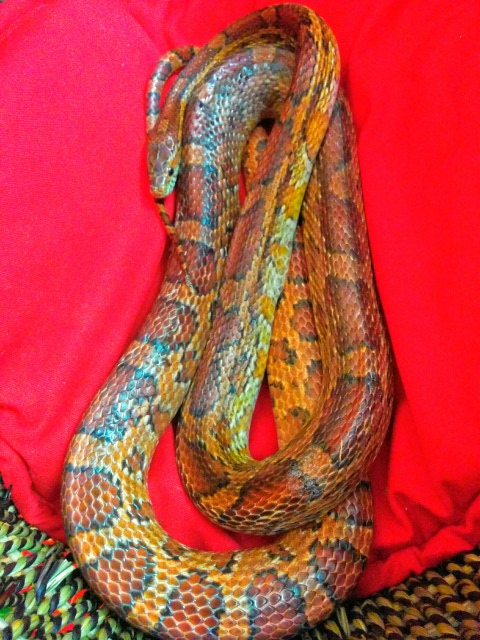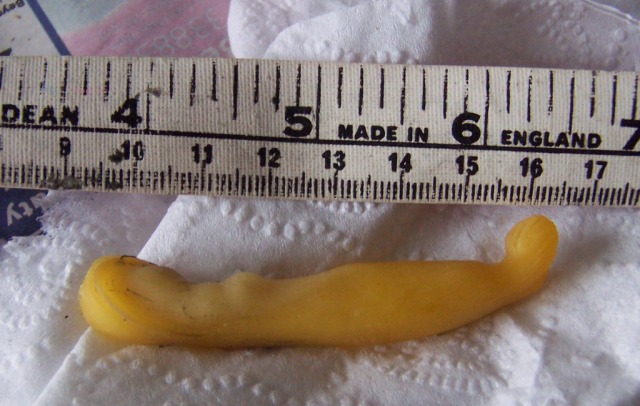Questioni have about a one and a half year old king snake i got it a a local pet store but the owner didnt no exactly what type it was he has a light greenish and yellow color with brown marking bye his eyes and all the way down his body so can u please tell me what type he is so i can have the right habitat for him
AnswerHi Chris,
It is very difficult to tell if you do not know the origin state of the snake. Was it captive bred or wild caught? You might want to post a picture of the snake on the fauna boards. The good news is that most colubrids are similar to care for. I am listing a care sheet below that should work just fine.
With Kingsnakes being not only a wide ranging genus, but coming in a wide variety of sizes and haibtats,
it's hard to make a one size fits all caresheet. So, with this variety in mind, I'll try to include some of the
various methods used in keeping them happy and healthy.
Housings: There are many types of enclosures that can be used in keeping a Kingsnake. Most commonly
used ones are aquariums, rubbermaid tubs, and custom enclosures. When deciding on an enclosure for your
snake there are some "typical" rules of thumb that should be used. First, the base demensions(length +width)
of the enclosure should be at least the length of an adult snake. For Kingsnakes this can range from 24" to
over 6 ft. So, for some of the smaller species like the Scarlet Kingsnake a 10 gallon enclosure (20"x10") can
provide plenty of room. Where for some of the larger getula and triangulum species, a 50- 75 gallon
enclosure would be best. However, since the average size of most Kingsnakes is around 42"-48", a 20 gallon or larger is the most commonly used size. For snakes, there is no such thing as too big, as a matter of fact,
the bigger the better!! When using a sweater box or Rubbermaid type tub for your snake, most use at least a
32 qt. tub, again adjusting for the adult size of the species and based on the base demensions of the tubs.
One important thing to remember when using these types of tubs is drilling small air holes in the
side for airation. These holes should be small enough that the snake itself can't squeeze through. The
second point in deciding on enclosure type is how secure it is. Snakes are extremely adept escape artists!
They seem to be able to find any weak area in order to squeeze out. So, when buying your enclosure be
sure to include a secure fitting top. For aquariums, most use screen tops with clamps to hold them on
the tank. For Rubbermaid types, most come with locking tops , however it should be understood that
the larger the tub, the weaker the tops tend to hold them in. This is because most only lock on the sides
with the middle being flexible, allowing the snake to push up in the middle and squeeze out. This is also
true of the screen lids on larger aquarium enclosures. So, in these cases more clamps should be used.
Temperature/Thermal Gradient: Being snakes are ectothermic (cold blooded) and rely on their surround-
ings for body temperatures, it's required to give a temperature range or thermal gradient to allow for proper
temperature regulation of the snake. An OPTIMUM gradient would be from about 55-95 degrees F within
the enclosure. This would allow your snake any and every temperature it may need for any needs it may
have at any time. But, since such a wide range is hard to attain in captivity, most advise to give a general
range of about 75-85 F. This is because most studies have found that this is the range they seem to be
most active. This range allows for proper digestion of their prey, and SEEMS to be low enough to allow
for "down time". With this said, it should be remembered that by adding to this general range allows for
better temperature regulation for your snake. For instance, a snake that has access to a range of 70-90 F
has more tempertures to choose from to thermal regulate, and can better control it's body temperatures
than one with a narrower 75-85 degree range. Wider gradients are much easier to attain in larger
enclosures, and should be yet another consideration when pcking out your enclosure.
Setting up Gradients: To set up your enclosure's temperature range, should will first need two
thermometers, one for each end of the enclosure. You can use either the stick on types used for fish
aquariums, or digital themometers with extendable probes (typically much more accurate). These should
be set up near the bottom of the enclosure on either side to read cool side and hot side temps. You will then
need a heat source to heat the hot side of the enclosure. You can use use either heat lamps placed on top of
the screen lid, or a heat mat, heat pad or heat tape, which is place under one side of the enclosure to heat
one side. Adjusting the hot side temperatures using a heat lamp is a matter of switching out to either higher
or lower wattage bulbs till you attain a desired temperature. Heat mats, heat pads, and heat tape should be
hooked up or plugged into a rheostat, dimmer, or thermostat to adjust them to the desired temperature.
Without one of these limiting devices it is possible to overheat the enclosure (most snakes can only
survive a short time in temperatures above 100 F) and also possibly cause a fire from the heat pad itself
overheating. Heat rocks should never be used because they only allow for a limited heat source and
typically a snake will coil around them and burn themselves on them. As stated above, a wider gradient
is the prefered wat of determining your enclosure temperatures. If however you can only seem to
attain a limited range as with a smaller enclosure, it's possible to fine tune your temperatures to your
snakes preferences. Since Kingsnakes come from a wide range and habitats, some seem to prefer
higher temperatures, while others will prefer cooler temperatures. Fine tuning your temperatures to your
particular snake is a matter of observation. Set up your enclosure to the "general settings" stated above,
and watch how your snake uses them. If it seems your snake is constantly curled up on the cool end of
the enclosure (outside it's hide) it's telling you the enclosure is too hot and the temperatures should be
lowered a bit. If however, your snake always seems to be constantly on the hot side, you should raise
your temperatures a bit. You can play with these ranges till your snake seems to use the entire enclosure
at various times. Remember though, that snakes do tend to be more secretive animals and usually stay
in their hides (discussed later) most of the time.
Substrate: Many types of substrate can be used.The most important thing to remember when picking yours is that you should NEVER use pine or cedar shavings, because they are toxic to reptiles. I've read that you shouldn't use sand either, because it can become ingested and cause intestinal problems. I've heard of people using Aspen shavings, reptile bark, newspaper, paper towels, aquarium stones, and astro turf made to fit the tank you have.I personally use the astroturf because I think it gives the tank a cleaner appearance, plus its fairly easy to clean.
Ornaments:The things a snake most needs in it's tank is a hide box or two, and a water dish. A hide box is like it's den in the wild.You can buy a hide box in most pet stores, or I've heard of people using old flower pots with a hole cut into it for the snake to get in and out. I've even heard of people using old shoe boxes or tissue boxes for theirs. Just as long as your snake has a place it can go to feel secure in it's environment.One thing to remember is the hide box is the snakes "get away", so it's not advisable to take your snake out of it as this may cause the snake undo stress.The water dish is pretty basic, it should be large enough for your snake to soak in. It doesn't have to be big enough that it can submerge its whole body in at a time, just enough so it can get wet if it wants to. Another good idea is to put a climbing branch in for your snake. Kingsnakes love to climb (at least mine do). Besides that you can put just about any object in your tank as long as its non-toxic or non-poisonous to your snake.
Feeding: Kingsnakes do very well on a diet of just mice. Baby and juvenile snakes should be fed pinkies(newborn mice). As your snake grows you should give it larger prey items.Petstores usually sell them in stages from pinkies to fuzzies to hoppers to small adults and large adults.You should feed your snake every 7-10 days. Most herpers suggest to feed frozen mice to eliminate the possibility of mites and disease and possible harm to your snake from a biting and scratching mouse. If you choose to feed frozen mice it is VERY important to make sure the mouse is properly dethawed all the way through or it may cause severe digestive problems for your snake.The best way to dethaw a mouse is to put it in a small pan or dish with hot water till it feels soft and warm all the way through.(usually 15 minutes to an hour depending on the size of the mouse) If you choose to feed your snake live prey it's better to "pre-kill" or stun the mouse so it won't harm your snake.This can be done in several ways. I've heard of putting the mouse in a small bag and slamming it to a hard surface. Another thing I've heard of ,but never tried, is to grab the mouse by the tail and behind the head and pull in opposite directions (this is supposed to break its spine instantly, thus killing it).I've never tried it so I can't positively say if it works or not. Another thing you can do is to put it in a plastic sandwich bag and suffocate it. It's best to twist as much air out of the bag to shortern the time it takes. You can also make a simple CO2 chamber, which is considered the most humane way of euthanizing a mouse. Or you can just put it in with your snake and risk having the mouse bite or scratch your snake. One thing to remember when feeding a snake is that you should feed it outside it's tank or enclosuer.If you don't, you risk having the snake think it's feeding time whenever you open it's tank, and run the risk of the snake ingesting it's substrate with it's meal.The last thing to remember is not to touch the mouse with your hands as this will leave it's scent on you and your snake might think your a mouse and bite.
Handling: Most Kingsnakes are fairly timid snakes when being handled. Juveniles tend to be a bit more to handle than the adults. Many juveniles will rattle their tails, musk and strike out to defend itself from what it sees as a large predator. Although they act tough, just picking them up in the middle of the body is the easiest and less stressfull way to pick them up. They seldom bite, and if they do, it doesn't hurt since they only have fine teeth. Once they reach adulthood, they typically settle down to the point they will come to you when the tank is opened.(albeit more in a search for a way out than recognition of you) When you are holding your snake support it's body with one hand and control it's head with the other. Don't pinch or hold it behind it's head. This can injure it, and make handling more stressfull on both of you. Another thing to remember is to not hold your snake after you feed it for at least two days because it might stress the snake out and make it regurgitate it's food.
Hybernating: It's not nescesary to hybernate your snake unless you plan to breed it.To hybernate your snake you should stop feeding your snake for about 2 weeks to make sure it's system is clear, then slowly drop its tank temperature down to about 55-60 degrees over a couple of days so they can adjust to the change. You should also turn any light off earlier to make appear as a shorter winter day. Usually about 2-3 months is plenty of time for it to hybernate. After it has hybernated just do the opposite and slowly warm the tank over a few days. Some snakes tend to slow down naturally without any temperature changes. They will also sometimes refuse to eat during this time. It's not unusual for a kingsnake to go without feeding for 2 months or more, especially during cooler months. As I said before, it's not nescesary to hybernate your snake, as a matter of fact, I've heard of people loosing they're snakes from trying.So unless your planning to breed your snake I wouldn't advise it.

 Bad Shed
QuestionNoser
QUESTION: I have a 19 month old ma
Bad Shed
QuestionNoser
QUESTION: I have a 19 month old ma
 White patches on redtail boa
Question
Boa Boa
I have a five year old ma
White patches on redtail boa
Question
Boa Boa
I have a five year old ma
 What is this?
Question
Snake pictue
We found a small snake in
What is this?
Question
Snake pictue
We found a small snake in
 Possible Causes for sudden death of Corn Snake?
Question
Saturn My Living Corn
I am utterly dev
Possible Causes for sudden death of Corn Snake?
Question
Saturn My Living Corn
I am utterly dev
 Weird thing produced by king snake
QuestionSnake Discharge
QUESTION: Im looking aft
Weird thing produced by king snake
QuestionSnake Discharge
QUESTION: Im looking aft